
Best Practices for Board Orientation
The board of directors plays a vital role in maintaining the organizational structure of a company. This elected group oversees the organization’s activities and meets periodically to discuss and vote on business affairs. Given the critical role board members play in an organization’s overall success, these individuals need to be up-to-speed on the company’s mission and goals. That’s where board orientation comes into play.
Board orientation is when new board members are provided with detailed information on the organization and their role within it. Whether the process is approached formally or informally, an engaging board orientation can encourage new board members to become committed ambassadors and advocates of the company’s mission.
Effective board orientations acquaint newly elected board members with their role, the organization and the team. A thorough, engaging onboarding process can make new board members passionate about achieving the strategic mission and vision of the company. To ensure critical topics are covered, begin the orientation process by issuing a binder to new board members. This binder should be provided before their first meeting, so they have the opportunity to review and make notes for questions. Topics should include the company’s history; year-to-date highlights of the board; board member roles and responsibilities; a list of current board members and committees; previous meeting minutes and a schedule of upcoming meetings; recent financial statements, revenue information and organizational expenses; strategic planning documents and bylaws; and detailed agendas for the first meeting new board members are attending.
The chair of the board, executive director or CEO, chair of the recruitment committee, lead program person and lead development person should all be present during board orientation to welcome, inspire and educate the new board members. Typically, the recruitment chair will run the meeting itself since they brought the new members on board and should work to retain them by building upon their established relationship. The chair of recruitment can create a presentation for board orientation that outlines the following:
- The company’s mission, purpose and framework of operations
- Details on what the board does and member expectations
- The company’s organizational structure
- How voting works
- Current projects and goals for the future
- The company’s strategic direction
- A financial overview of the organization
- The board’s meeting schedule
Board orientation should provide important information about the organization to new board members and begin to build working relationships among board members to promote a supportive environment. A thorough orientation can also reduce the likelihood of liabilities arising since new members will have a better understanding of the policies and procedures of the company and the board of directors. For more risk management guidance, contact us today.
This document is not intended to be exhaustive nor should any discussion or opinions be construed as legal advice. Readers should contact legal counsel or an insurance professional for appropriate advice. © 2023 Zywave, Inc. All rights reserved.

Discussion
There are no comments yet.